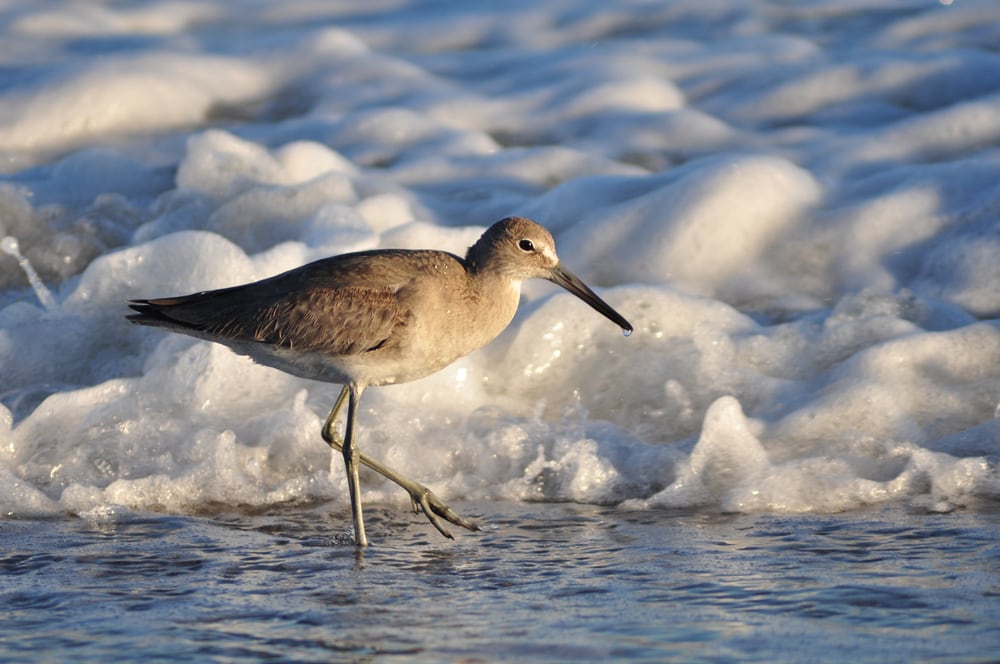
Florida is an amazing state for bird-watching. There are nearly 200 species of birds that call Florida home, including wading birds, seabirds, and birds of nearly every color.
It’s nearly impossible for anyone who heads to the beach to avoid running into the birds that frequent Florida’s shorelines. The sea birds of Florida can range in size from fitting in the palm of your hand to looking you in the eyes and can be nearly any color you can imagine.
In this article, we’ll discuss the shorebirds you’re most likely to run into on Florida’s beaches.
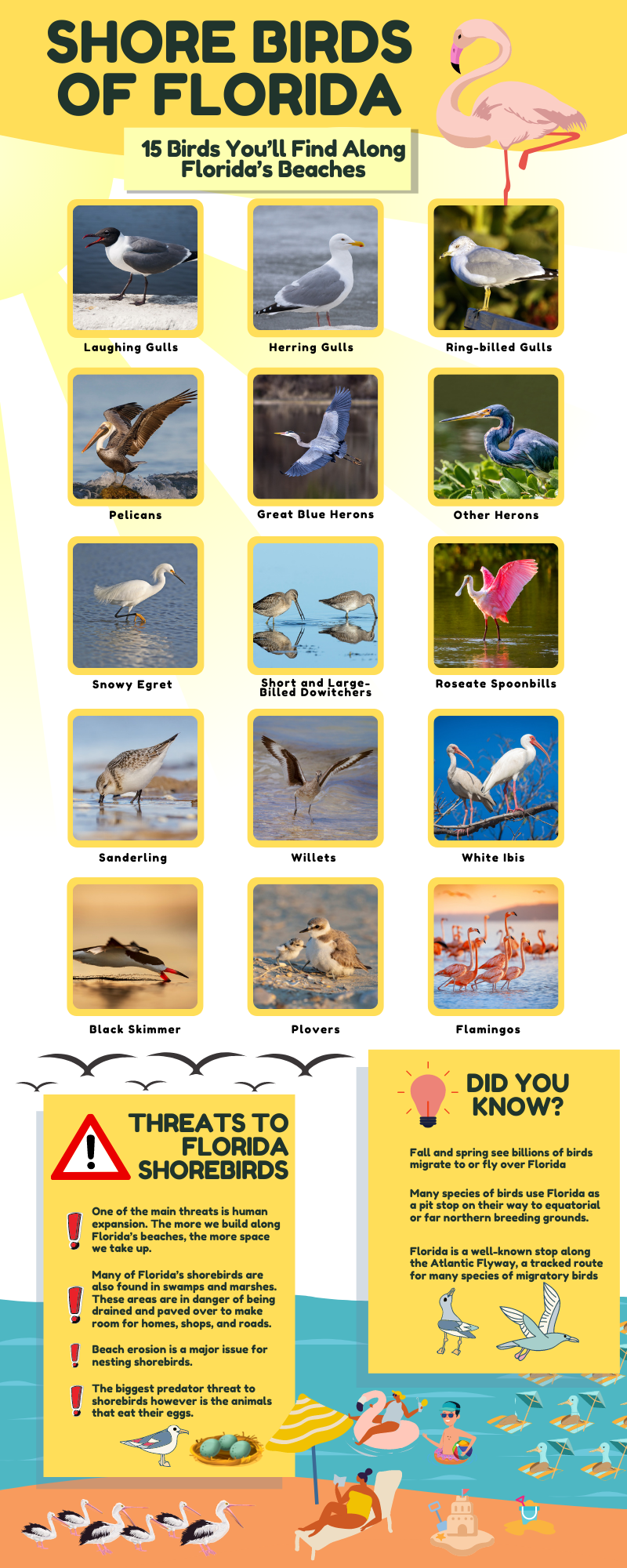
Share This Image On Your Site
<a href="https://outforia.com/shore-birds-of-florida/"><img style="width:100%;" src="https://outforia.com/wp-content/uploads/2022/01/Shore-birds-of-florida-infographics-01282022.png"></a><br>Shore birds of Florida Infographic by <a href="https://outforia.com">Outforia</a>You May Also Like: Check Out These 3 Types Of Scorpions In Florida complete with Photos, Infographics, Facts, and more!
15 Shore Birds of Florida with Pictures
1. Laughing Gulls
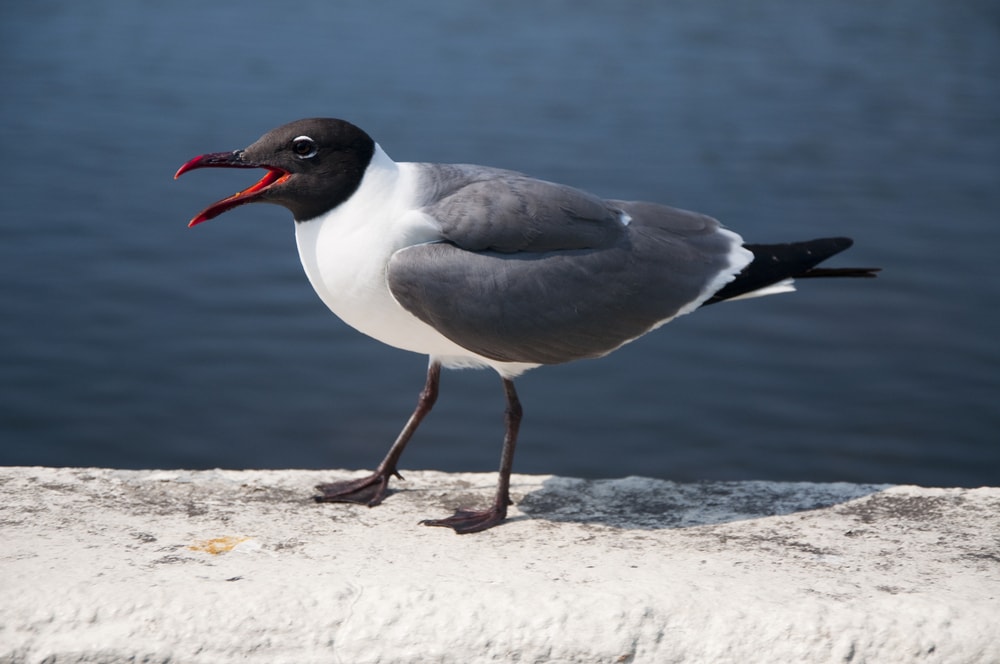
Laughing gulls are likely the most common bird you’ll see on a Florida beach. They’re also the ones you think of first when you think of seagulls. These gulls get their name from their distinct calls that sound like they’re laughing.
Typical laughing gulls have a wingspan of 36 to 47 inches (91 to 119 centimeters) and weigh between 7 and 13 ounces (198 and 368.5 grams). You can tell them apart from other gulls because of their black or mottled-black head feathers.
Like other sea birds, laughing gulls tend to build their nests in large colonies. They’ll usually be more active at night, but they still harass beachgoers for food during the day.
Laughing gulls primarily feed on insects, small fish, invertebrates, and even other birds’ eggs. They can forage while swimming but tend to fly low over the water and plunge to snag prey beneath the surface.
2. Herring Gulls
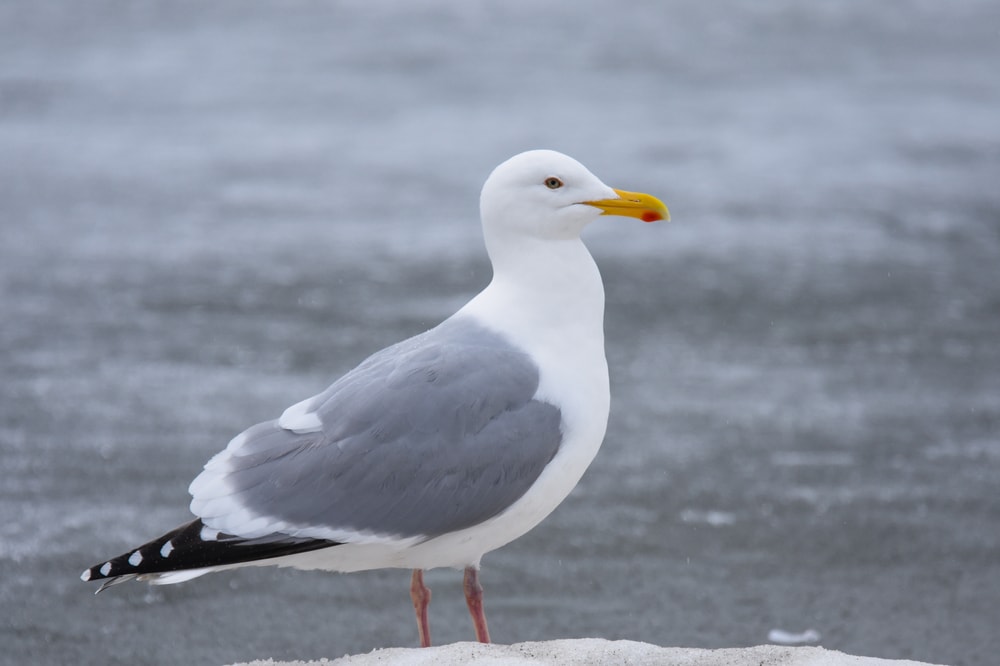
Herring gulls are another seagull you’ll frequently find along Florida’s beaches. They stand out thanks to their pink legs and the fact that they’re much larger than laughing gulls.
A typical herring gull will have a wingspan over five feet (1.5 meters) and weigh two to four times as much as a laughing gull. They tend to nest in more isolated areas, ranging farther than other gulls in search of food.
Herring gulls feed mostly on fish and are one of the gull species fishermen use to help locate fish offshore.
3. Ring-billed Gulls
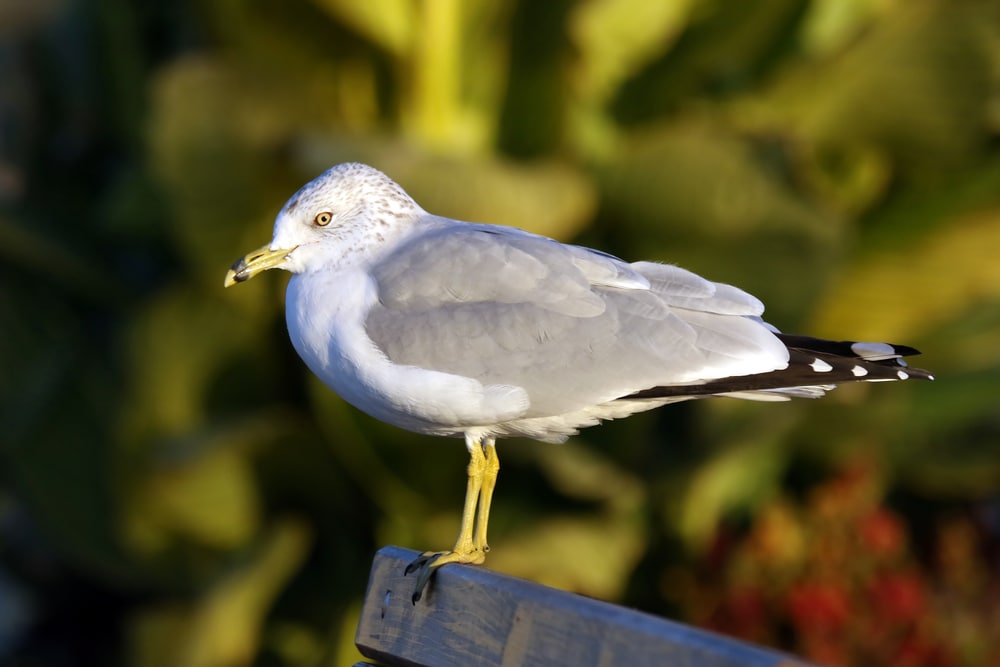
Ring-billed gulls are like the smaller cousin of herring gulls. They have mostly white and gray plumage and a distinctive black ring around their yellow bill that helps you identify them. Their legs can be a range of colors, including yellow, pink, gray, orange, red, and black.
Typical ring-billed gulls have a wingspan of 41 to 46 inches (104 to 117 centimeters) and weigh between 10 and 24 ounces (283 and 680 grams). Like other gulls, they nest in large colonies and swarm together in the air in groups called flotillas.
Aside from being preying on insects, fish, and invertebrates, all gulls are scavengers. They’ll pick through anything they can find laying on the ground, whether that’s a dropped ice cream, spilled chips, or regular old garbage.
Gulls aren’t shy around other gulls and compete for food, even taking food from each other’s mouths. Like with gulls of other kinds, they aren’t shy around people and will regularly harass beach-goers for food in areas where they’re regularly fed by people.
4. Pelicans
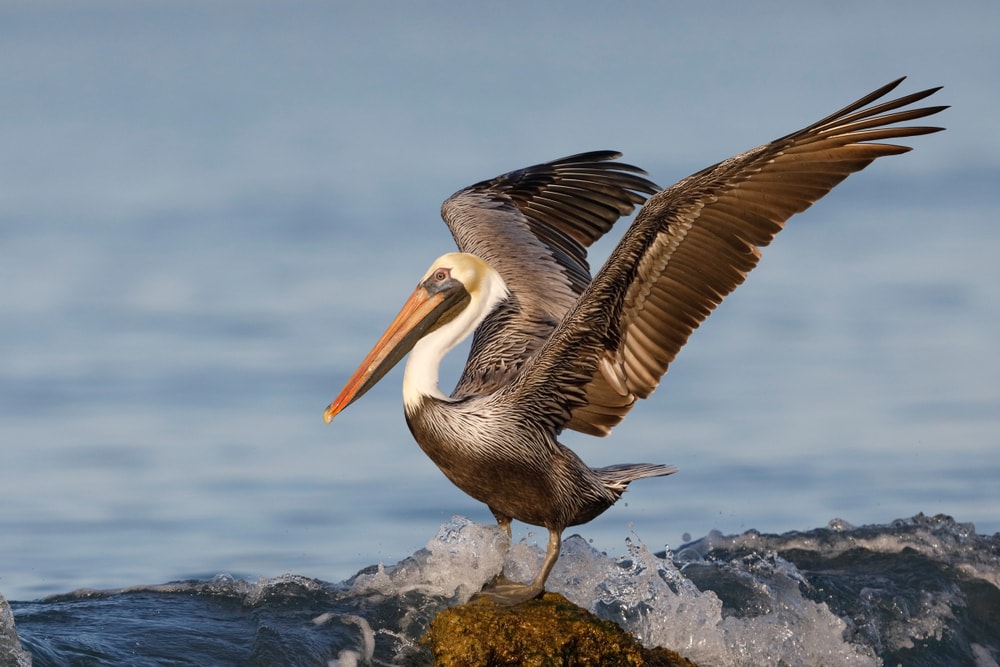
The state bird of Louisiana and the national bird of Barbados, Saint Martin, Saint Kitts and Nevis, and the Turks and Caicos Islands is the brown pelican. You’ll find them flying across most of Florida’s beaches, scooping fish into their large beak pouches.
Brown pelicans can have wingspans over six feet (1.8 meters). They have a long skinny neck and a long bill with an almost comically large throat pouch. Many pelicans can even push their spine out of their throat to help keep them cool in extra hot months.
Look for pelicans hanging around fishing piers or gliding over the water in groups searching for fish to gobble up.
At one time, the brown pelican was a critically endangered species. This was because of pesticide runoff entering waterways and getting into the fish they ate. After certain pesticides like DDT were banned in the state, they’re recovered and are no longer endangered.
5. Great Blue Herons
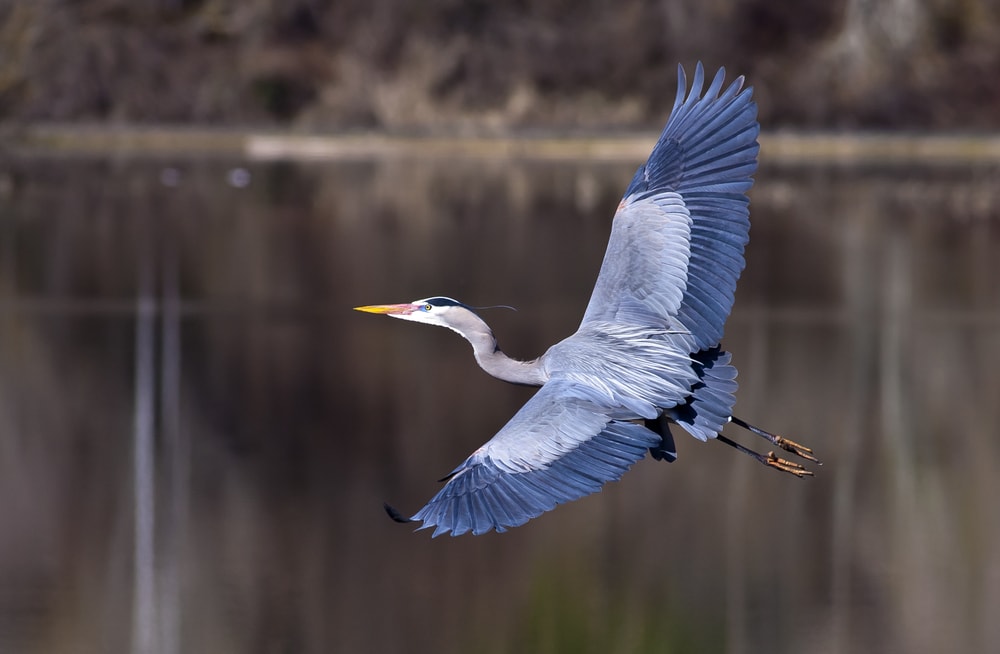
While there are more herons on Florida’s beaches that we’ll discuss in the next section, I’m giving great blue herons their own section. Mostly because they’re so common on the beaches that I spend time on and I have plenty of experience and stories about them.
These birds have long legs, long bills, and extremely long necks. Large birds can stand nearly five feet (1.5 meters) tall and have wingspans of nearly seven feet (2.1 meters). Most of their plumage is a grayish blue color.
Herons can be found most often prowling marches, swamps, and lakes, but in Florida, they also walk along the surf line. They’re usually solitary and territorial birds that feed on fish, invertebrates, and even small mammals and Florida snakes.
In populated areas, these huge birds are pretty friendly towards people if you keep your distance. I’ve spent many a day fishing on the beach with the same heron standing ten yards away waiting for me to throw something back.
Big blue herons can be intimidating and will even try to steal your fishing bait if you aren’t watching. I had one work up the nerve to rush towards a box of squid that was sitting on the ground next to a chair I was sitting in.
6. Other Herons
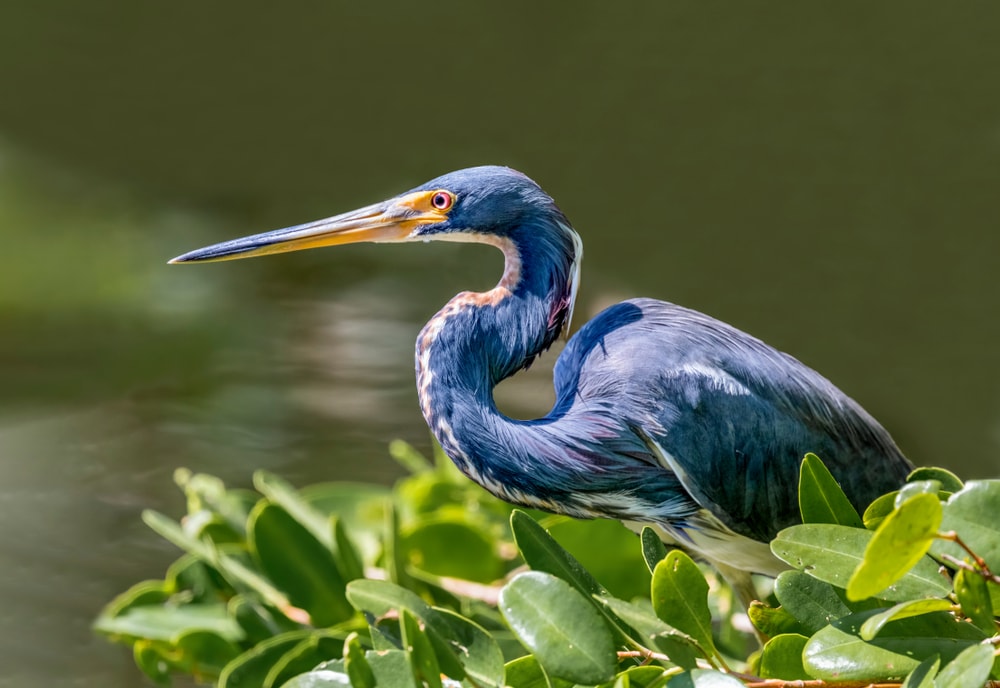
Aside from great blue herons, you can find both little blue herons and tricolored herons on Florida’s beaches. Little blue herons are a smaller version of great blue herons with a deeper blue plumage and smaller dimensions. Tricolored herons are around the same size but have a white stripe running the length of their necks.
Both of these birds have wingspans around three feet (0.9 meters) in length and weigh under a pound (under .45 kilograms). Like larger herons, they’re found most often around lakes, swamps, and marshes, preferring to hunt alone.
You might have also heard of great white herons, similar in size to great blue herons but with completely white plumage. This isn’t a different heron species, nor are they actually egrets, they’re simply a white-colored variant of blue herons.
7. Snowy Egret
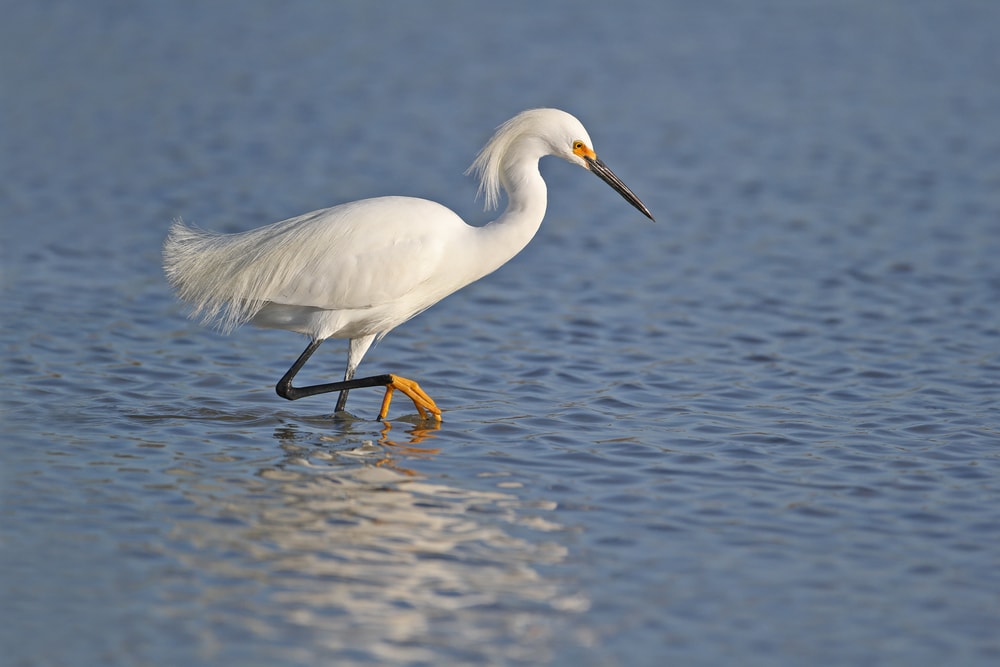
Snowy egrets are large, mostly white birds that are slightly smaller in size than great herons. They have long black legs and bright yellow feet to contrast their all-white appearance.
You’ll mostly find them in tidal zones prowling for small fish that are trapped, invertebrates, snakes, insects, and frogs.
Snowy egrets nearly went extinct in the 18 and 1900s because of the demand for their feathers. Since then, migratory bird treaties and other protections have allowed populations of snowy egrets to rebound.
8. Short and Large-Billed Dowitchers
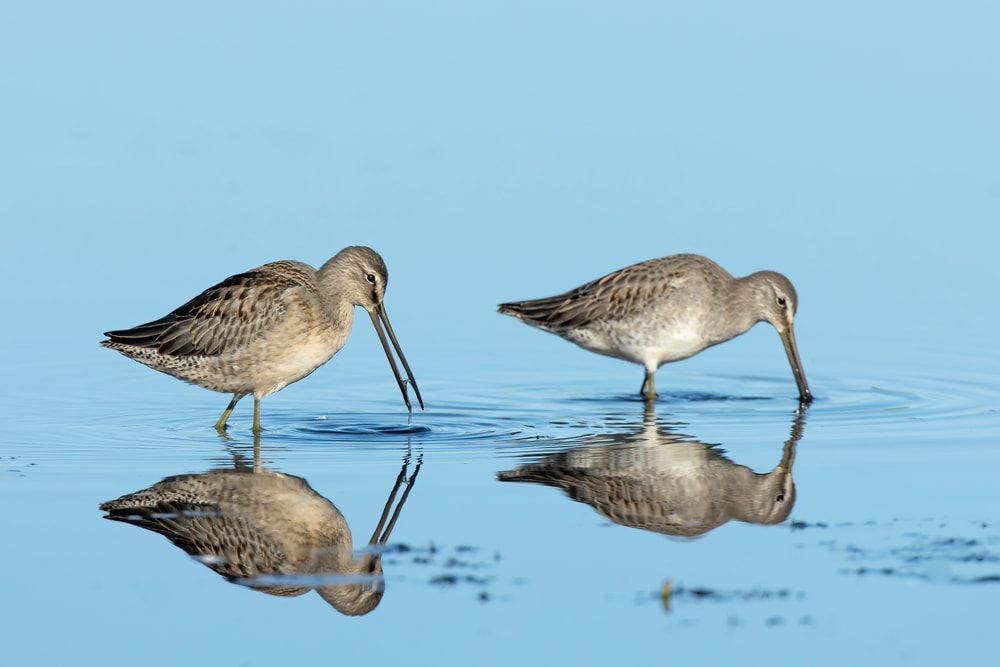
Dowitchers are the amusing little birds you’ll see running up and down the beach avoiding waves as they crash up the beach. They’re typically brown or light gray and have long, thin bills. Rather than flying, they’re more likely to simply run away from people if they get too close.
You can tell short and large-billed dowitchers apart just by the length of their beak and the fact that they have different calls. Aside from that, the two species are roughly the same size, hunt the same way, and have very similar appearances.
They stick their long bill into the sand and root around for food. They poke into the sand like a very slow woodpecker looking for worms and invertebrates to eat.
Like a lot of shoreline birds, you can find them in large groups quite often. Both species can form groups numbering in the hundreds and nest along the sand dunes, saw grasses, and tidal flats of the Florida coast.
9. Roseate Spoonbills
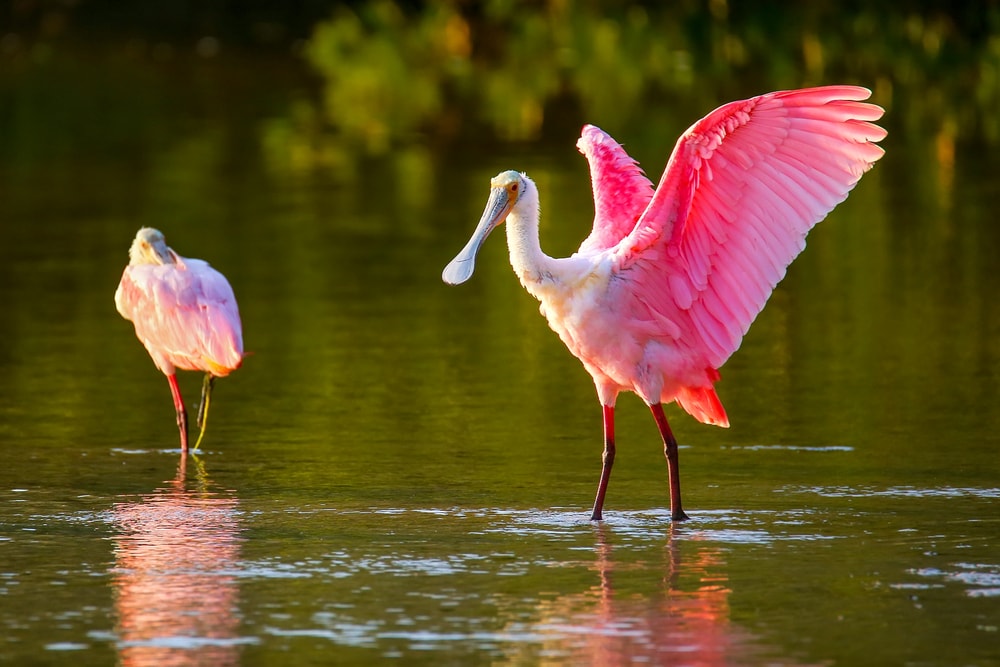
The roseate spoonbill is an aptly-named wading bird that has bright pink plumage and a beak that widens at the end in the shape of a spoon. They quite often get mistaken for flamingos when their beak isn’t visible.
Typical roseate spoonbills have a wingspan between 47 and 51 inches (119 and 129.5 centimeters) and weigh under four pounds (1.8 kilograms). They’re not fond of crowded beaches, so you’ll need to go to less populated areas if you want to find one.
These spoonbills hunt by moving their beaks back and forth in the water and snap it shut when a fish, insect, or shrimp finds its way between its jaws. You can find them mostly in intercoastal waterways, lakes, estuaries, and marshes.
10. Sanderling
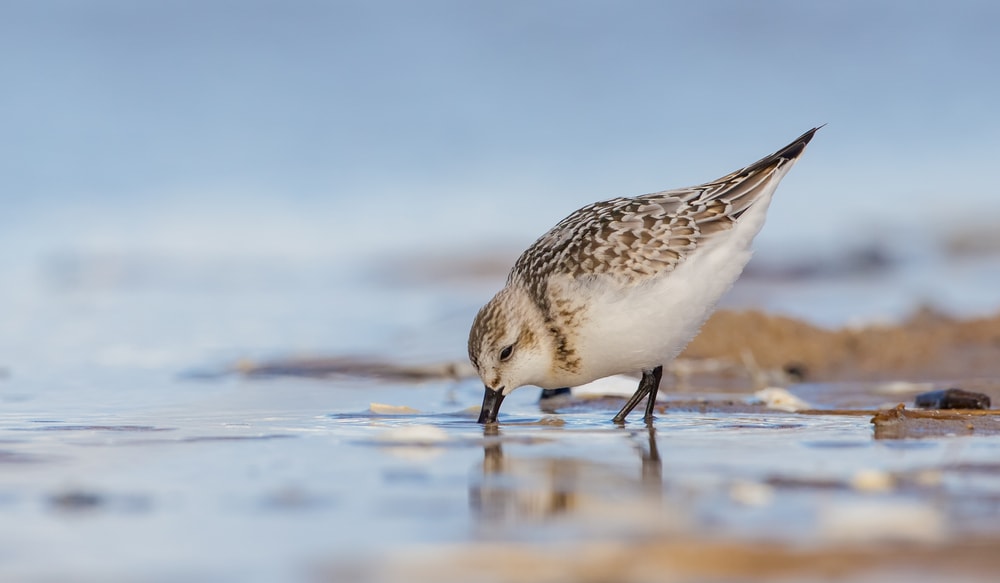
Sanderlings are cute, chubby little sandpipers with a black beak, fluffy white and gray feathers, and black legs. You’ll see them most often at the water’s edge scurrying away from waves while they peck the sand for food.
Most sanderlings have wingspans of around a foot and weigh only a few ounces. They nest in colonies but are typically found in groups of around a dozen or less.
Sanderlings are highly migratory, as they breed in the Arctic tundra and migrate south. You won’t find them around all year, only in the colder months.
Most of their diet consists of sand crabs, insects, marine worms, and small mollusks. They use the waves to help uncover their food and poke into the wet sand to snag prey before the next wave comes up the beach.
11. Willets
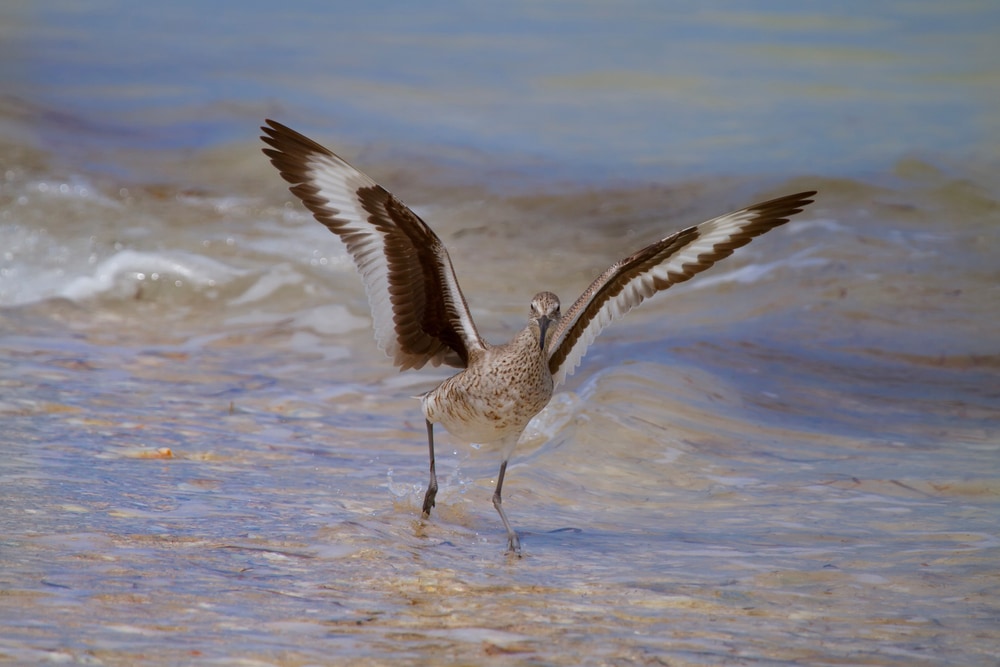
Willets are best identified by the black and white stripes on their wings, which you won’t see while they’re wading on the beach. They have a gray to brown plumage and a long black bill.
A typical willet has a wingspan of around 27 inches (68.6 centimeters) and weighs between 7 and 11 ounces (198 and 312 grams). You’ll commonly spot them along the beach both alone or in groups.
Like a lot of birds on the list, they use their bills to probe the sand for aquatic insects, crustaceans, small fish, and worms. Their typical habitat is shallow marshes and swamps, but they’re one of the more common birds you’ll see at the beach.
12. White Ibis
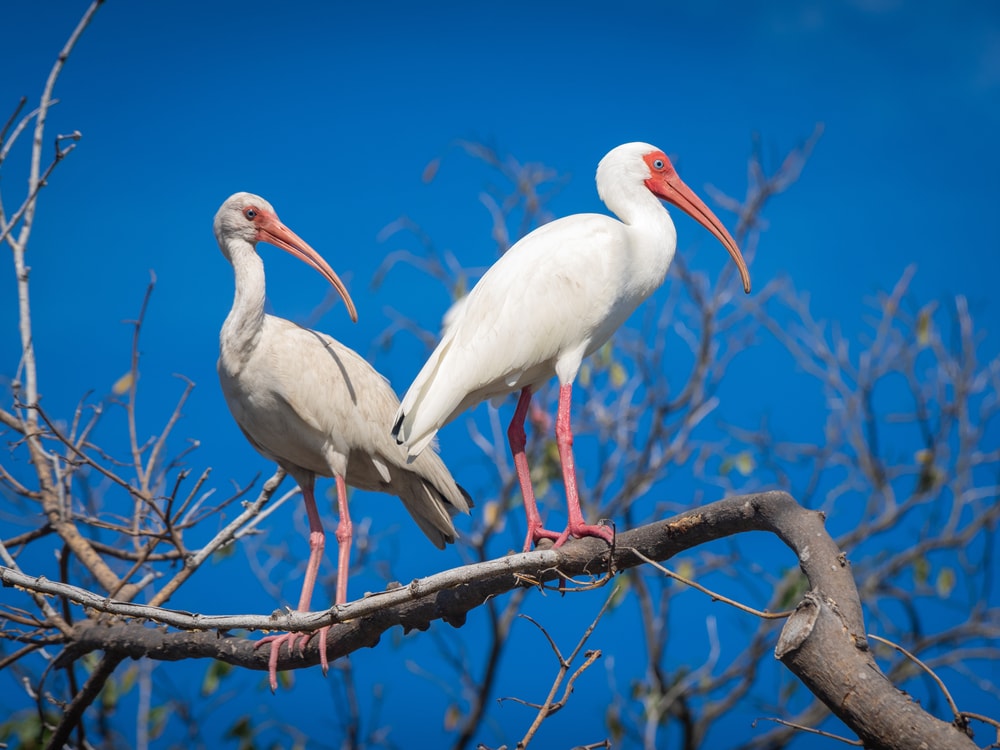
White ibis is a football-shaped, white bird with a pink face and legs. They have a long, curved bill and black wingtips. You’ll mostly see them protecting their nests from other ibis and birds.
A typical white ibis has a wingspan of around three feet and weighs between 26 and 37 ounces (737 and 1,049 grams). They’re an incredibly common bird in most of Florida and spend time in beaches, marshes, swamps, and shallow-water areas.
The most defining attribute of white ibis is their protectiveness. They fight with each other constantly to protect their nests and mating partners. Most of their diet consists of insects, invertebrates, and small fish that it probes for and scoops from the water.
13. Black Skimmer
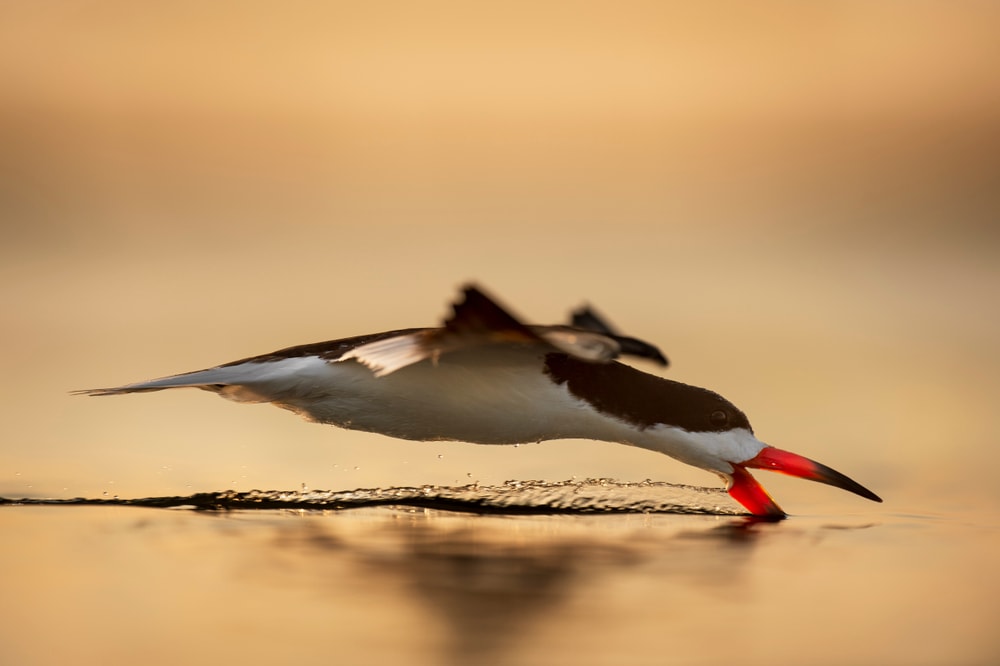
Black skimmers have a black back and upper portion of their body with white covering their bellies and undersides. They usually have an orange bill with a lower jaw that’s longer than their upper jaw.
A typical black skimmer has a wingspan of around 43 inches (109 centimeters) and weighs between 9 and 13 ounces (255 and 368.5 grams). They frequently flock together in large groups and fly in sync, even flapping their wings at the same time.
Black skimmers feed by literally skimming the surface of the water. Instead of spotting fish, they fly with their lower beak skimming through the water and quickly snap their beak shut when they touch a fish. These fish make up most of their diet.
14. Plovers
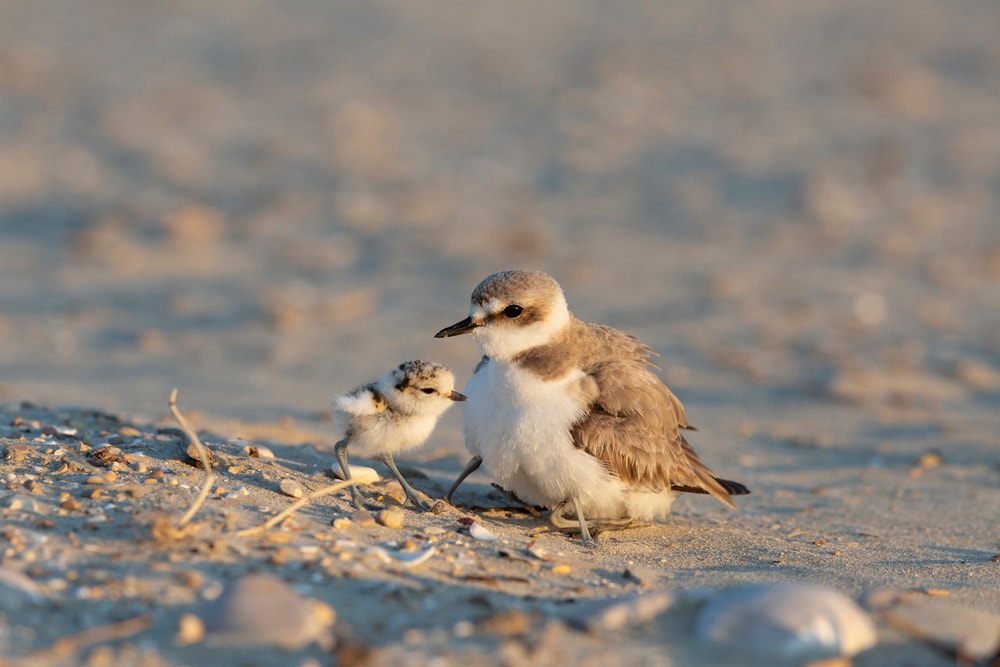
There are a number of small plover species that spend time on the beaches of Florida. Most of the time, they’re similar in body shape and size. They have short necks that almost make them look like a little fluff ball.
Florida offers a home to black-bellied plovers, piping plovers, Wilson’s plovers, semipalmated plovers, and snowy plovers. These birds spend most of their time foraging for food in the sands of the tidal zone.
15. Flamingos
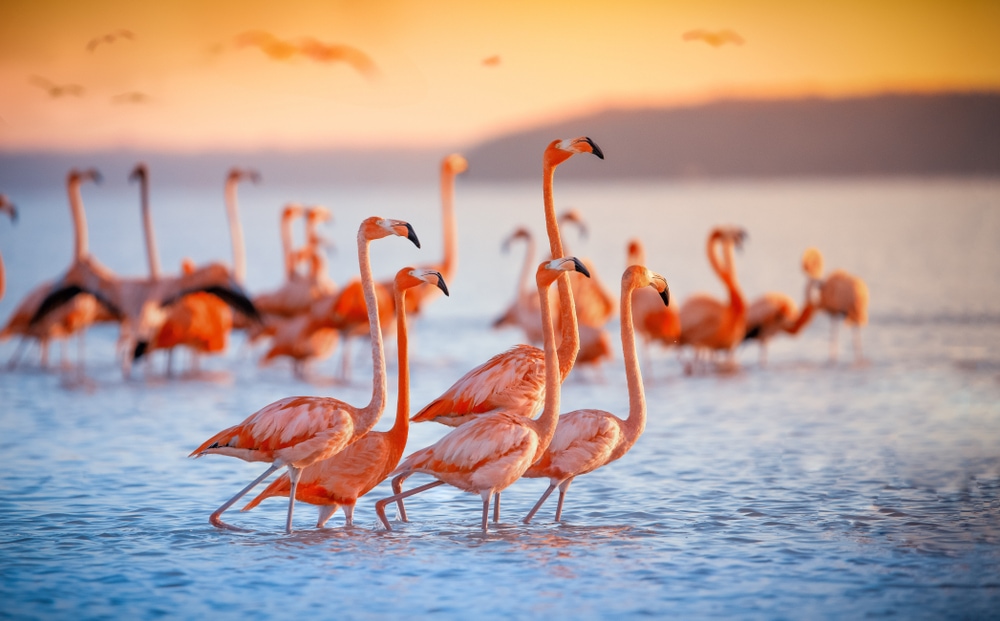
Whether or not flamingos are native to Florida, you can find them here. The greater flamingos that frequent the Everglades and Florida shores are bright pink birds that can stand around five feet tall.
They’re a bit rare in the Sunshine State as the greatest numbers of flamingos spend their time in more isolated state parks. However, now and then you’ll see them on beaches from south Florida to the panhandle.
Flamingos are large wading, long-necked birds that feed on small invertebrates like brine shrimp, algae, insect larvae, small seeds, and small fish.
You May Also Like: Discover The Largest Alligator Ever Recorded in Florida with Facts, Photos, Infographics, and more!
Shorebirds Life Cycle
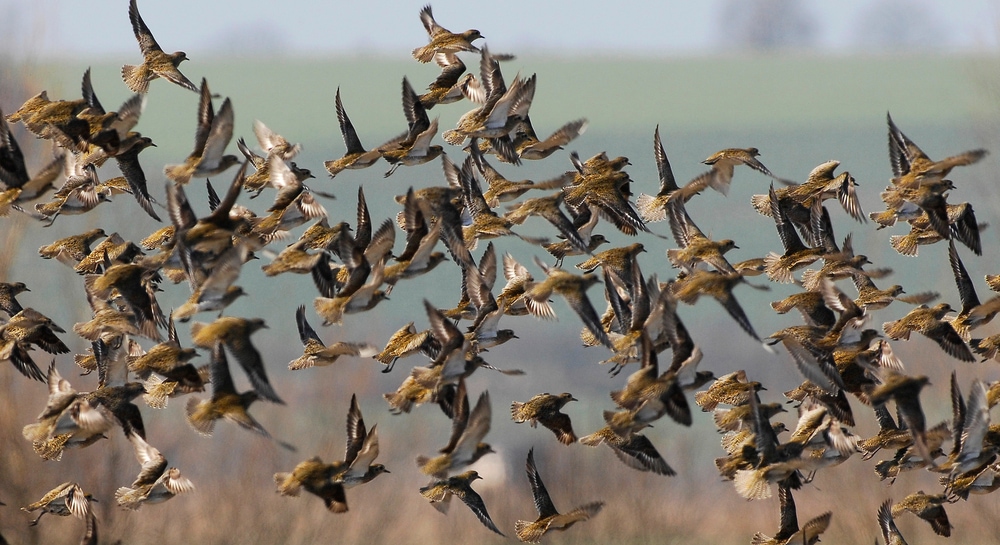
Some shorebirds spend their entire lives along the beaches. Birds like gulls, albatrosses, and pelicans can be found far out at sea in search of fish to scoop up. Wading birds like herons and egrets split their time between beaches and lakes, swamps, and marshes. Since they can fly, birds move around a lot. In the case of non-migratory birds, they go where the food is.
Many of the birds you can find in Florida are highly migratory. They’re either using Florida as a pit stop or they’re in Florida to breed. Rarely are shorebirds consistently in the same place for very long.
Most birds will grow up quickly, leaving their nests to migrate to their seasonal homes where they feed. They then migrate back to the same place they were born to have young of their own. These seasonal breeding grounds are typically federally protected to help ensure healthy populations of a variety of bird species.
Shorebirds Migration
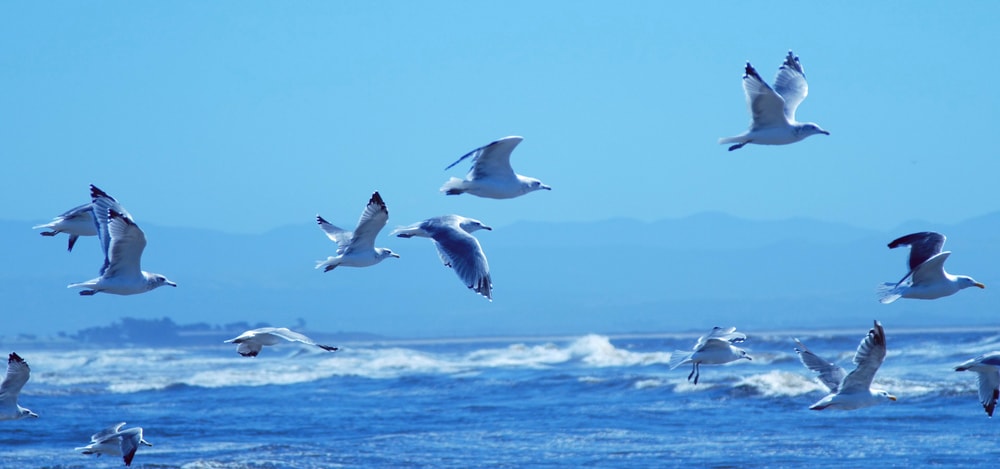
We’ve all heard that birds fly south for the winter. The case is similar for many of Florida’s shorebirds. A plethora of bird species found in Florida are migratory species, coming to breeding grounds on Florida beaches from the far north and South America.
Fall and spring see billions of birds migrate to or fly over Florida. Migrating birds are tracked by attaching bands to birds’ legs to help track their movements around the world.
Many species of birds use Florida as a pit stop on their way to equatorial or far northern breeding grounds. After crossing oceans they burn much of their fat stores and need to stop eating.
Florida is a well-known stop along the Atlantic Flyway, a tracked route for many species of migratory birds. Tracking stations along the Atlantic coast can be found in Florida, Georgia, South Carolina, and North Carolina.
You May Also Like: Discover These Sharks In Florida That You Should Know About with Photos, Infographics, Facts, and more!
Shorebirds Nesting
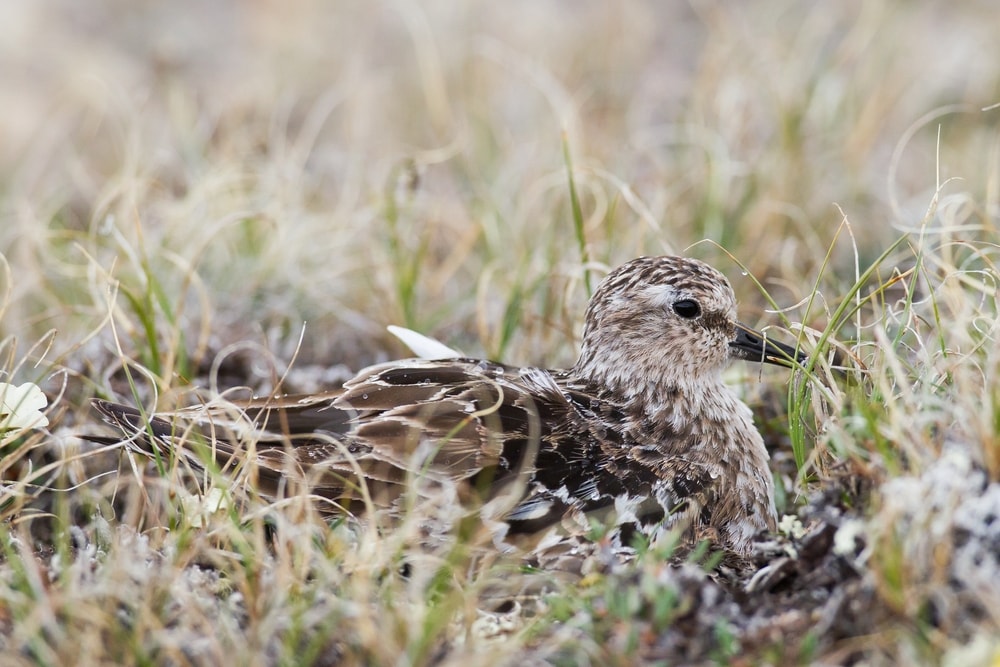
You can find a full list of shorebird nesting seasons here. Most of the birds found along Florida’s beaches also nest on those beaches. Sand dunes and the grasses that hold them together are ideal nesting sites for many of Florida’s shorebirds.
Many of the colonies that have been identified are within state and national seashores and parks in Florida.
Gulls, terns, herons, and a mix of migratory and non-migratory species make their nests along and on the beaches. Areas, where nests are concentrated, are usually either cordoned off or have specific protections in place to keep people from destroying nests.
For instance, in the Gulf Islands National Seashore, a low speed limit is heavily enforced to help protect many of the walking birds that cross the road.
You may also like: Check Out the 7 Species of Majestic Owls in Florida: Complete with Images, Facts, and More!
Human Interactions to Florida Sea Birds
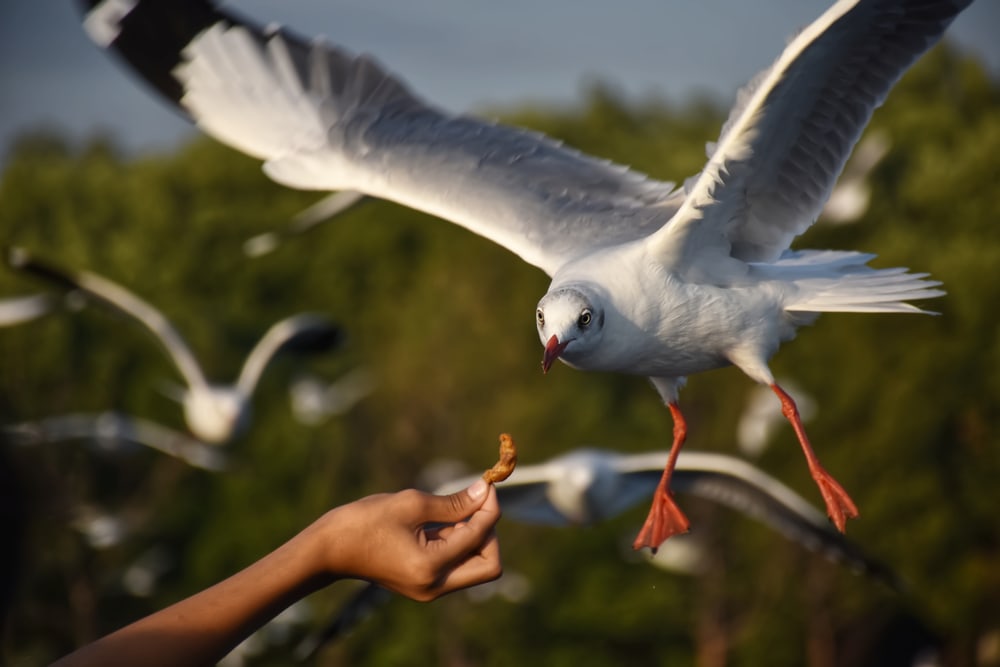
People and birds both like the beach, so they constantly come into contact with each other. Many gull populations have become reliant on people for food. This happened both because people feed them and they can get into trash easily.
Birds often frequent fishing piers to go after released fish or steal bait from fishermen. In populated areas, birds aren’t afraid of people and will even take food right out of their hands.
In most places, it will be against state guidelines or beach rules to feed birds.
Not all interactions are bad. Many offshore fishermen will follow or look for birds to help them locate fish. The baitfish schools that game fish follow are also food sources for seabirds. It’s a lot easier for fishermen to spot big, diving flocks of birds than it is to wander into a baitfish school.
You may also like: Get to Know the 14 Different Types of Birds of Pennsylvania: Complete with Images, Facts, Descriptions, and More
Threats to Beach Birds of Florida
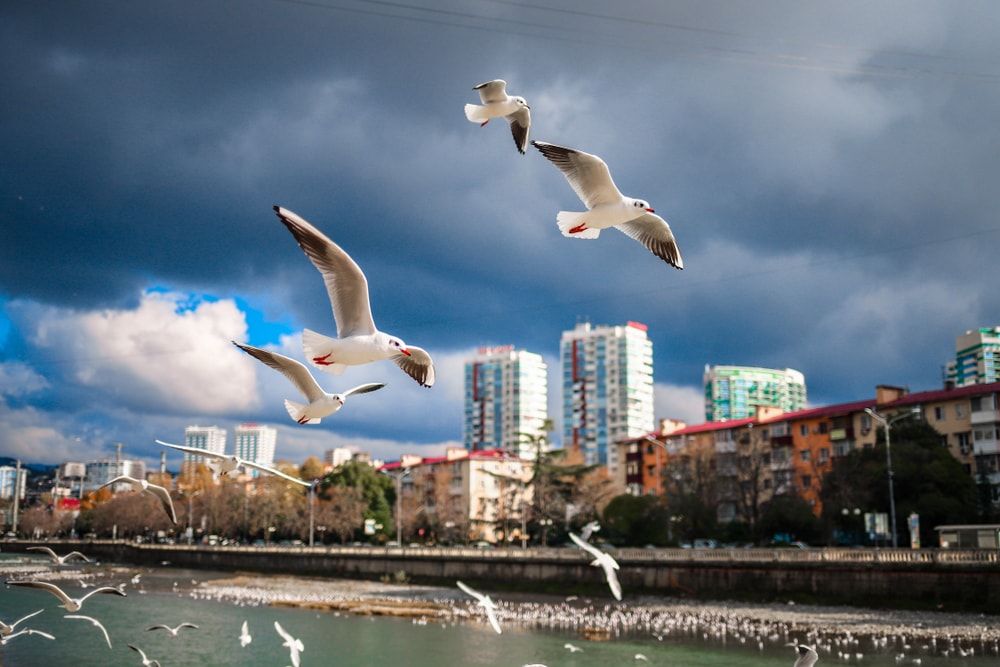
There are several threats to shorebird populations that are worthy of discussion.
One of the main threats is human expansion. The more we build along Florida’s beaches, the more space we take up. This can disturb, destroy, or bulldoze ancestral nesting sites for birds.
Many of Florida’s shorebirds are also found in swamps and marshes. Outside of state and national parks, these areas are in danger of being drained and paved over to make room for homes, shops, and roads.
The more people that are around, the more likely it is that walking birds can be hit by cars, nests can be accidentally damaged, and birds become dependent on people for food.
Beach erosion is a major issue for nesting shorebirds. On most of the barrier islands that line the Gulf Coast of the state, sand dunes and grass are what hold islands together. Hurricanes and human damage can destroy these dunes and fields, taking away important nesting and feeding areas.
Even walking paths across dunes can be enough to cause erosion that impacts nesting environments.
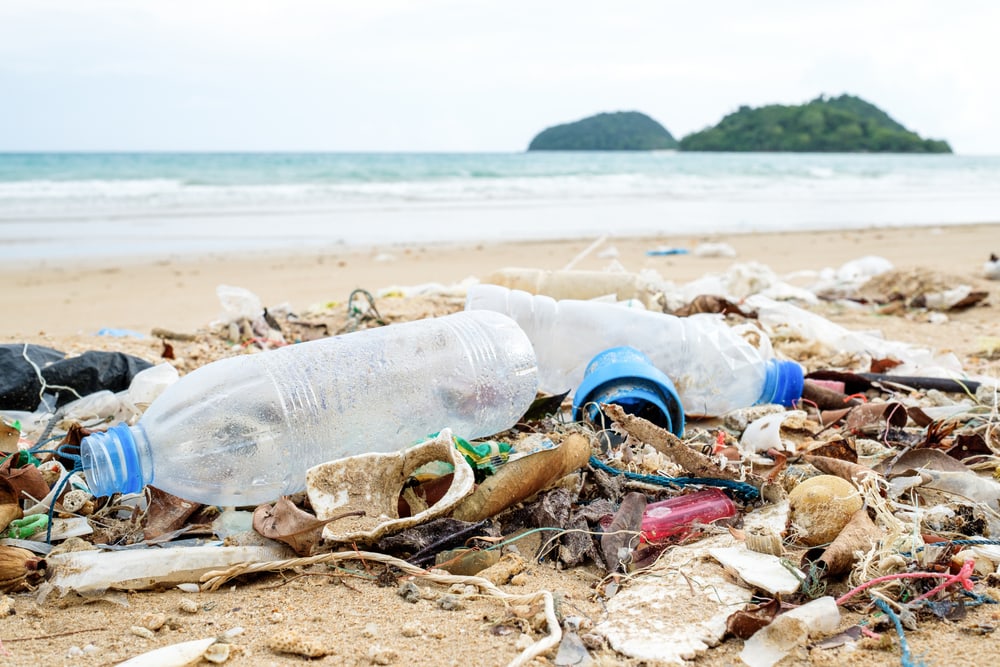
Pollution is another major problem for birds. Pesticide and chemical runoff that gets into rivers, estuaries, and waterways also gets into the organisms the birds rely on for food. When they eat those organisms, they essentially get poisoned. The brown pelican is a prime example, and while that was largely corrected, the problem persists today.
Plastic pollution is another major issue. Whether a bird mistakes plastic for a food source or gets caught up in plastic bags or six pack can rings. This kind of garbage pollution can cause life-threatening circumstances for shorebirds.
Predators are a natural threat to shorebirds. Raptors like eagles and hawks are major predators of smaller shorebirds. Some sharks like tiger sharks and bull sharks will frequently target and eat shorebirds feeding on the surface of the water.
The biggest predator threat to shorebirds however is the animals that eat their eggs. Raccoons, foxes, weasels, snakes, and lizards can all destroy and empty a bird’s nest. With many shorebirds nesting in large colonies, it creates a literal buffet for those animals.
Invasive species compound the problem. Tegu, Nile monitors, and wild boar will dig up and eat eggs from birds, turtles, and alligators. The extra pressure from invasive species can have a huge negative impact on shorebird populations since in many of these cases, they can’t defend their nests from these animals.
You May Also Like: Get To Know These Wild Monkeys In Florida And How They Got There with Photos, Facts, Infographics, and more!
Shorebirds In Culture
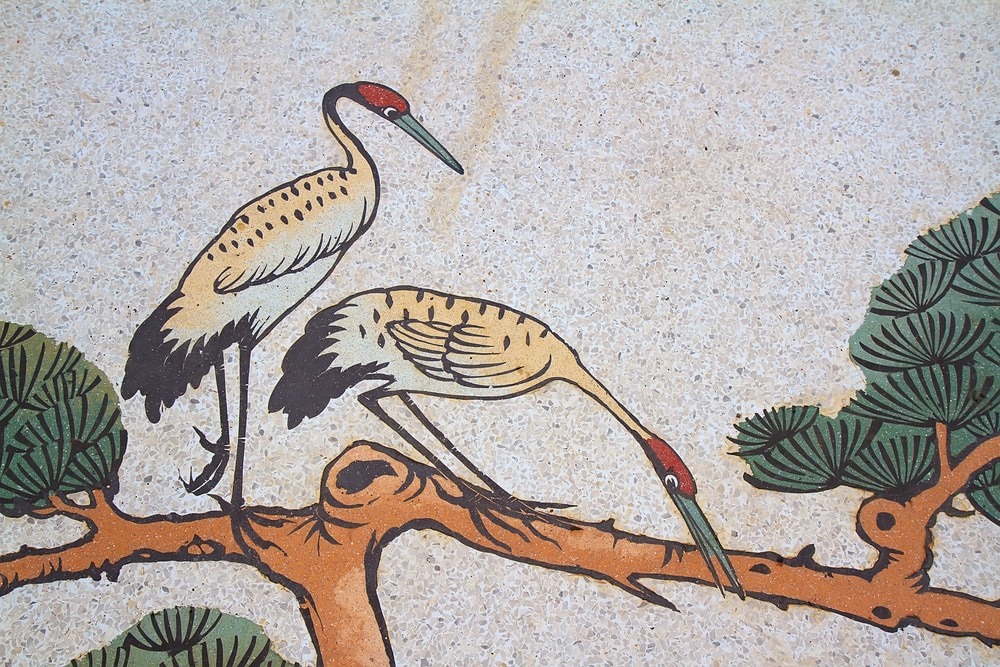
Shorebirds are a common thing to see as mascots for sports teams and icons for businesses.
The Florida Lottery uses a flamingo on its logo. Minor league and major sports teams include shorebirds as mascots as well. The New Orleans Pelicans and a minor league baseball team from Pensacola used to use the pelican as their mascot.
Pelicans were a big deal in my own city of Pensacola. The Pelicans of Paradise was a city-wide art project that erected seventy artistic statues of pelicans around the city.
You may also like:
Discover different species found in Florida here:

Wild Monkeys In Florida | Poisonous Frogs In Florida | Anoles In Florida | Birds Of Florida | Vultures In Florida | Woodpeckers In Florida | Hawks In Florida | Florida Freshwater Fish | Florida Frogs | Scorpions In Florida | Geckos In Florida | Florida Spiders | Lizards In Florida | Owls In Florida | Florida Turtles | Snakes In Florida | Alligators In Texas | Sharks in Florida | Largest Alligator In Florida |









